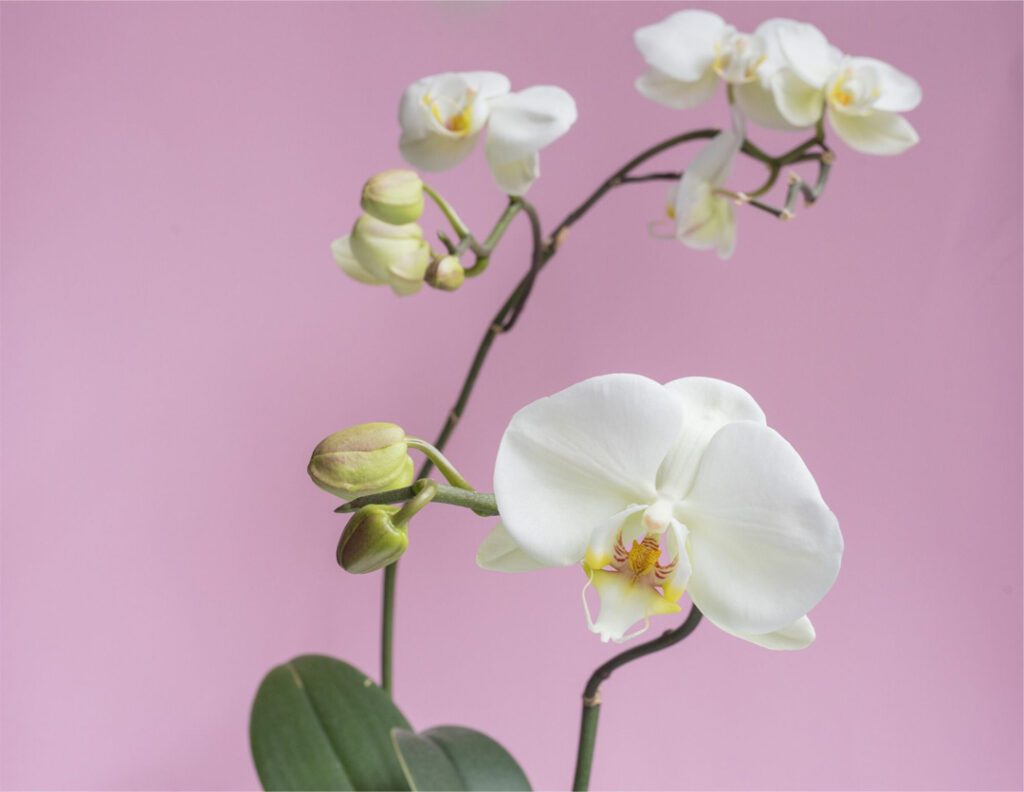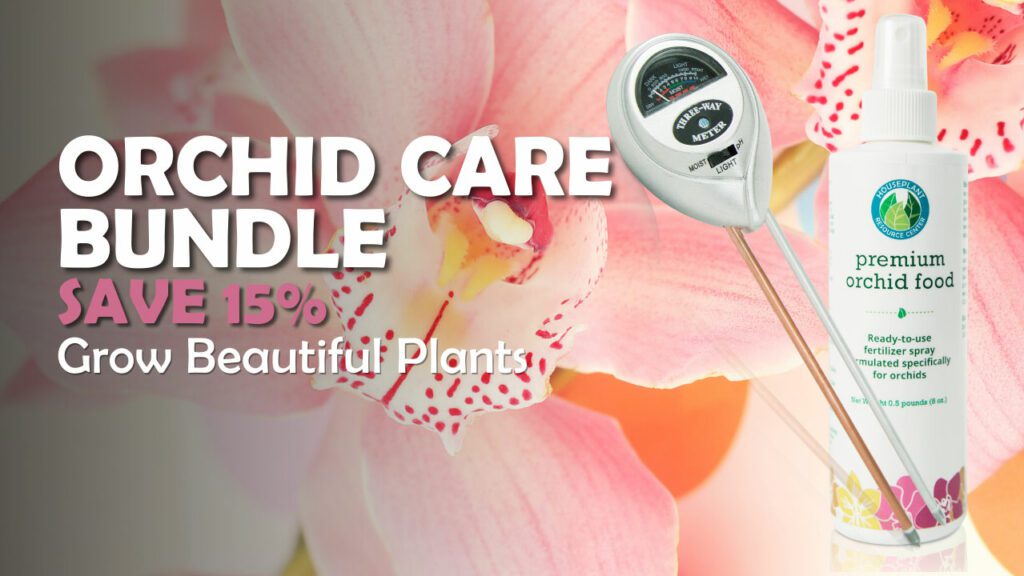We’ve compiled a list of 10 easy-to-grow orchid types to help you choose the perfect orchid for your indoor garden.
Orchids are one of the most diverse plants in the world. Currently, there are 22,000 known orchid species, and more are discovered each year. With so many orchid types available, it can be hard to choose an orchid that’s right for you and your home garden.
Depending on your expertise, budget, and home conditions, you may be drawn more to some orchid types than others. For example, some orchid species require bright light, while others require low light conditions. Some enjoy a warm, humid environment, while others do well in cooler temperatures.
To help you choose a perfect orchid for your garden, we’ve compiled a list of 10 easy-to-grow indoor orchid types. Below, you’ll find pictures, facts, and professional tips to make choosing an orchid easier than ever. And if you can’t pick just one, you can always try a few.
Indoor Orchid Type #1: Moth Orchids (Phalaenopsis)
Moth orchids, or phalaenopsis, are arguably the most popular and well-known type of orchid. You’ve probably seen them at your local supermarket or garden center.
Moth orchids are popular because they’re relatively inexpensive and have lush, showy blooms that can last between two and six months.
Since moth orchids are easy to grow, they’re ideal for beginner orchid growers. Moth orchids come in a wide variety of colors, including white, yellow, pink, and purple.
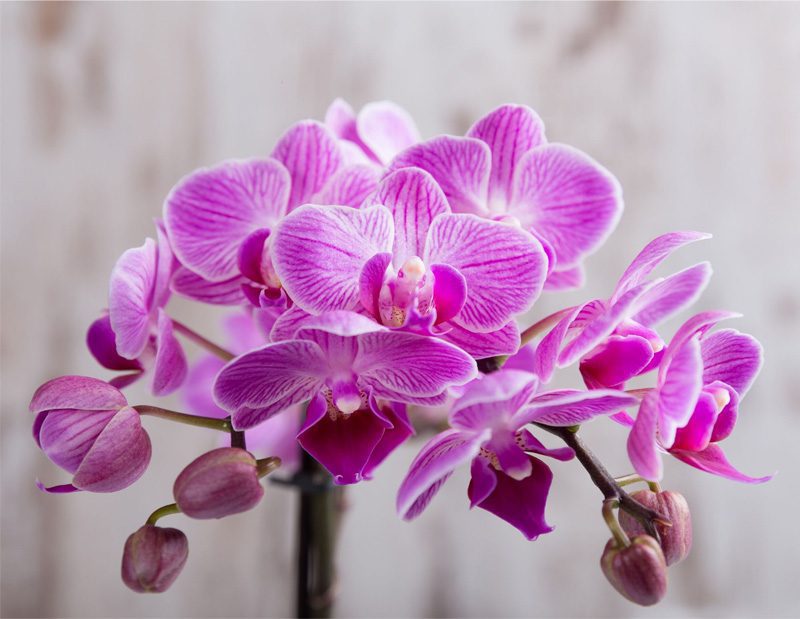
Professional Tip: Like most orchid types, moth orchids do well in humid climates. Place your moth orchid over a humidity tray. This will ensure the air around your plant isn’t too dry.
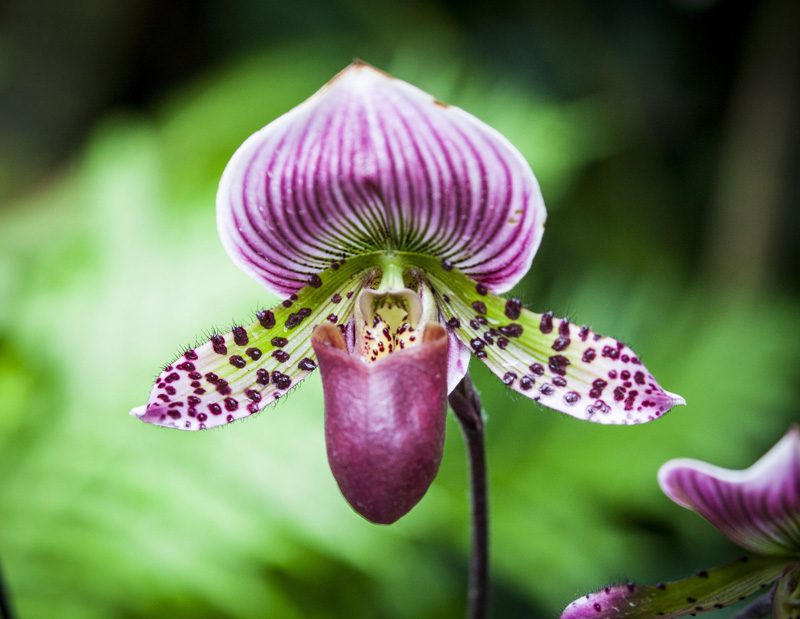
Indoor Orchid Type #2: Lady’s Slipper Orchids (Paphiopedilum)
Lady’s slipper orchids are distinct because of their unique pouch-shaped flowers. The pouch is backed by a sepal and two petals, which gives the bloom an insect-like appearance. In the wild, this attracts pollinators.
Lady’s slipper orchids bloom from autumn to spring. Often, the slipper petal is a different color than the rest of the bloom. Some varieties have dark green leaves while others boast dappled foliage year-round.
During the winter months, move your lady’s slipper orchid to a bright spot. Adequate light will encourage the orchid to bloom.
Professional Tip: Your lady’s slipper’s foliage will tell you a bit about its temperature preference. Lady’s slipper orchids with solid green leaves enjoy cool temperatures, while lady’s slipper orchids with mottled leaves enjoy slightly warmer temperatures.
Indoor Orchid Type #3: Dendrobium Orchids
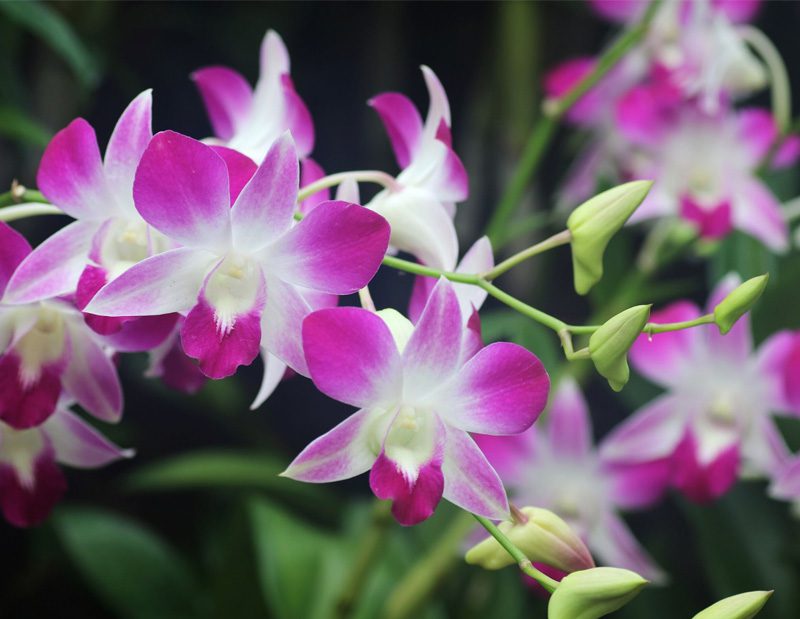

Indoor Orchid Type #4: Cymbidium Orchids
Cymbidium orchids flower abundantly from late winter until early spring. Typically, blooms last between six and eight weeks.
Cymbidium orchids enjoy warm temperatures during the day and cool temperatures at night. They are cold-tolerant orchids, though temperatures below freezing will likely harm your plant.
In the summer, move your cymbidium orchid to a shaded spot outdoors. Keep in mind that direct sunlight can easily burn your orchid; this is true for nearly all orchid types.
Professional Tip: To ensure your cymbidium orchid grows healthy flower spikes, maintain a 20- to 25-degree change in temperature between day and night. Moving your plant to a cool room overnight is a good way to ensure adequate temperature change at nighttime.
Indoor Orchid Type #5: Dancing Lady Orchids (Oncidium)
Dancing lady orchids are named after the shape of their unique blooms. If you look closely, you can see each bloom resembles a woman in a flowing dress.
These orchids are known for their plentiful blooms, since just one branch can boast hundreds of flowers. Typically, flowers will bloom during autumn months. Oncidium orchids come in a variety of colors, including various shades of yellow, purple, pink, and white.
Dancing lady orchids prefer well-aerated roots and medium to bright light. Hybrid varieties—which are popularly found in stores—enjoy cool indoor temperatures.
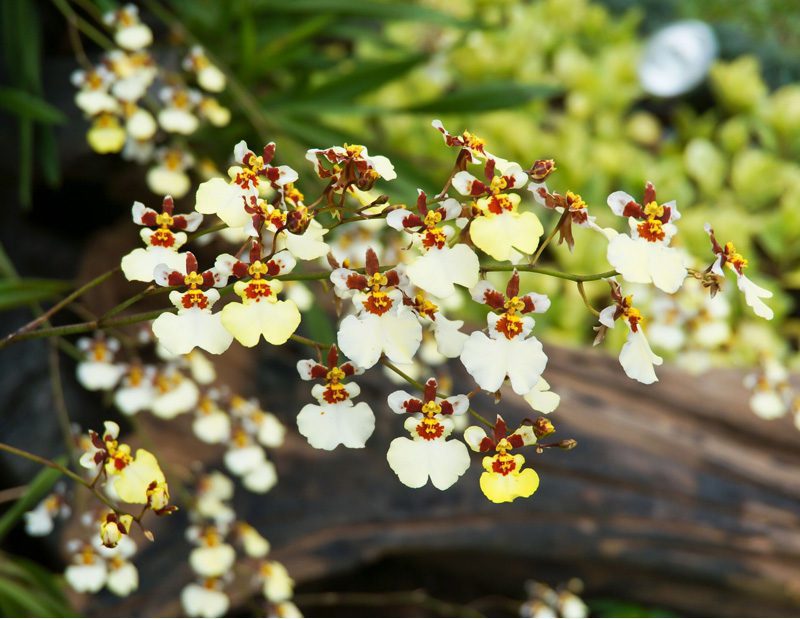
Professional Tip: Keep an eye out for fragrant dancing lady orchids. A scented orchid can add a wonderful note to your indoor garden.

Indoor Orchid Type #6: Cattleya Orchids
Cattleya orchids are commonly considered corsage orchids. They boast bright, showy blooms from autumn to spring. Some varieties have eye-catching patterns and emit a unique fragrance.
Cattleyas are native to tropical regions in the Americas, such as Costa Rica and Argentina. They’re popularly grown in greenhouses and other bright, humid indoor environments.
Unlike most orchids, Cattleya orchids can bloom twice a year. To encourage bloom, place your Cattleya in a south- or east-facing window so it gets adequate light.
Professional Tip: Cattleya orchids require less humidity than other orchid types. Use a humidity meter to keep humidity levels between 50-60% near your Cattleya. This will prevent your orchid from browning at its edges.
Indoor Orchid Type #7: Cockleshell Orchids (Encyclia)
Cockleshell orchids are known for their unique shape. Their signature lip can appear flat or ruffled, and their sepals mimic the tentacles of an octopus.
Cockleshell orchids are native to regions in tropical Central and South America; they can be found throughout Mexico, Brazil, and Argentina. Cockleshells are also native to areas in Florida, though their presence in the Floridian wild has been severely diminished by poachers and human activity.
Bloom typically begins in late spring and lasts through summer and well into the fall season. A mature cockleshell orchid can produce blooms year-round.
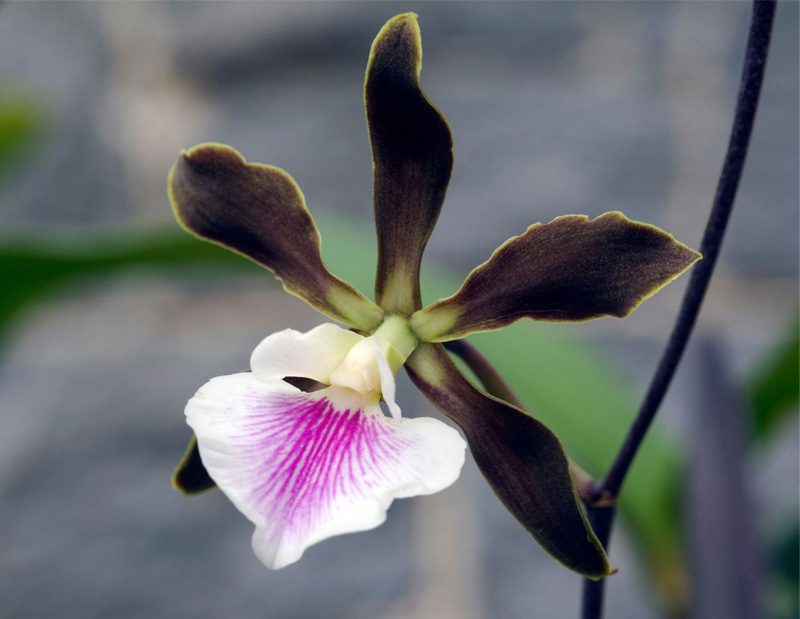
Professional Tip: Repot your cockshell orchid soon after new growth appears in the spring. This will encourage root growth to support new blooms.

Indoor Orchid Type #8: Nun’s Orchids (Phaius)
Nun’s orchids are named for their hooded flowers. They are among the easiest orchids to grow indoors since their needs can closely mimic those of your other houseplants.
These orchids are terrestrial plants. Unlike most orchid types, the nun’s orchid grows in traditional soil conditions. Keep the soil evenly moist, and let it dry between waterings.
Nun’s orchid flower stems can reach between 3 and 4 feet tall. Along the stems, flowers grow in clusters, and the plant often boasts rich green leaves. Blooms come in white, red, and purple varieties.
Professional Tip: Plant your nun’s orchid in a deep planter that allows plenty of room for the roots to grow. Since the nun’s orchid is a terrestrial orchid, use a commercial terrestrial orchid potting mix to ensure proper root health and encourage plant growth.
Indoor Orchid Type #9: Lady of the Night Orchids (Brassavola)
Lady of the Night Orchids are named after their nighttime fragrance. Each flower has a slender sepal and a heart-shaped lip. Depending on the variety, Lady of the Night Orchids may have purple or dark red spotting along their petals.
These orchids are native to coastal regions of Central and South America, and they can be found throughout the Caribbean islands. Naturally, they do well in tropical climates.
Unlike most orchids, which flower sparingly, Lady of the Night Orchids can flower multiple times per year. Most often, blooms occur in autumn or winter, though the plant can flower during any season.
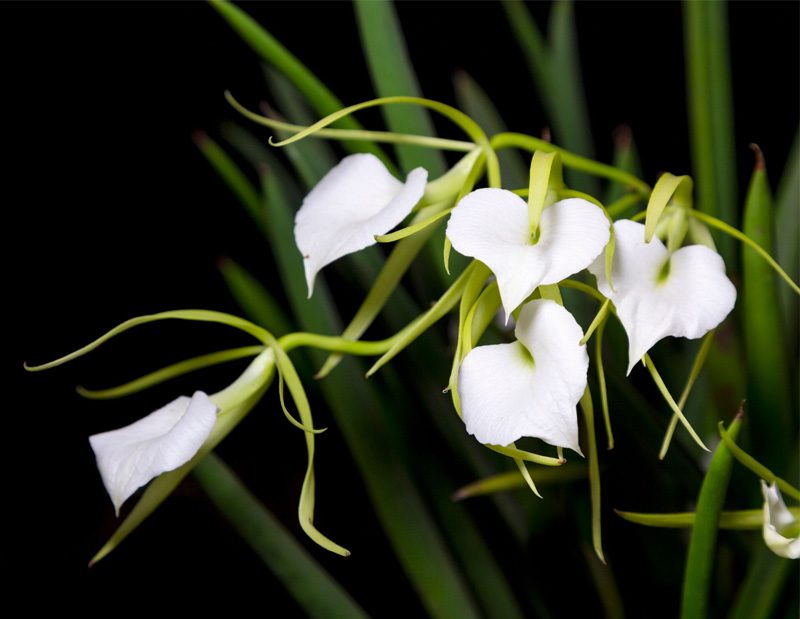
Lady of the Night Orchids are epiphytic orchids. They typically grow on trees or along cliffs near the shore. As such, they can be grown in a pot or on an orchid mount.
Professional Tip: If your Lady of the Night Orchid isn’t flowering, move it to a warmer position. Commonly, Lady of the Night Orchids that are kept in low temperatures have trouble producing blooms. Their ideal temperature is between 65° to 80° Fahrenheit with a 10° drop in temperature at night.

Indoor Orchid Type #10: Jewel Orchids (Ludisia)
Jewel orchids are quite unique. Jewel orchids are known for their deep green and violet foliage rather than their blooms.
In the wild, jewel orchids grow beneath the thick forest canopies of Eastern Asia. Direct sunlight will easily harm your jewel orchid. As such, keep your orchid in a low- to medium-light position; an east- or north-facing window is best.
Professional Tip: Without humid conditions, your jewel orchid may become too dry. If your jewel orchid’s foliage develops brown, crispy edges, put it on a humidity tray.
One Professional Tip for All Orchid Types
Once you’ve chosen an orchid type for your home garden, you’ll become familiar with its unique needs. Of course, the needs of your orchid will vary based on its species, native climate, and your own home conditions.
As you become familiar with your orchid, you can count on one thing to hold true: your orchid, regardless of its type, needs the right orchid food to stay healthy and produce blooms.
If you’re looking for the perfect orchid fertilizer to grow beautiful orchids with ease, try our one-of-a-kind Premium Orchid Food. Our unique formula is gentle so it won’t harm your orchid, and it’s liquid, which is an optimal delivery method for orchids since it’s easily absorbed.
Our fertilizer is also designed to be friendly to all orchid types. Simply spray the Orchid Food on your orchid’s leaves, roots, and potting mix every time you water. Then sit back and watch your plant bloom.
Click here to buy our Premium Orchid Food and start nourishing your orchid today.

